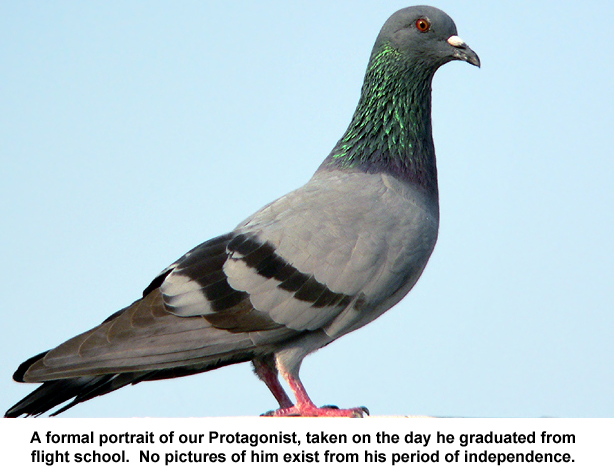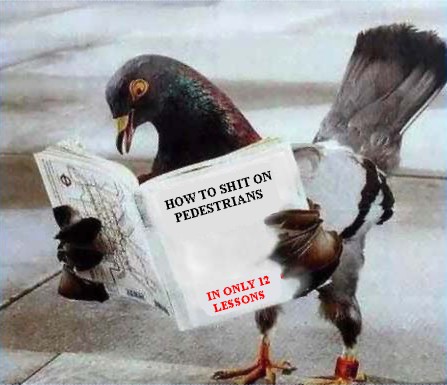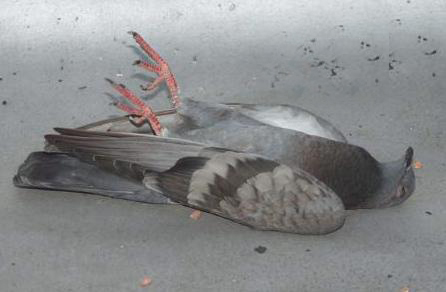 Years ago I was able to engage in the exciting sport of shooting feral barn
pigeons on a local farm. One weekend I killed one that had a leg band on it,
and, curious, I traced the bird's life history; it was pretty interesting.
Years ago I was able to engage in the exciting sport of shooting feral barn
pigeons on a local farm. One weekend I killed one that had a leg band on it,
and, curious, I traced the bird's life history; it was pretty interesting.  Years ago I was able to engage in the exciting sport of shooting feral barn
pigeons on a local farm. One weekend I killed one that had a leg band on it,
and, curious, I traced the bird's life history; it was pretty interesting.
Years ago I was able to engage in the exciting sport of shooting feral barn
pigeons on a local farm. One weekend I killed one that had a leg band on it,
and, curious, I traced the bird's life history; it was pretty interesting.
As an experienced user of the Internet, naturally I started by checking the FAQ ("Frequently Asked Questions") file at rec.birds, a USENET group for recreational birders. Sure enough, it contained the very FAQ I had: "I found a banded bird. What do I do?" and the advice to call the Bird Banding Lab at the Patuxent River Wildlife Center in Laurel MD . I did so, but as soon as I described the band, the nice lady I spoke to instantly knew it was from a pigeon, and therefore not of interest to them. It seems PRWC deals with "wildlife" only; had I shot a banded goose or something, they could have helped; but for pigeons the procedure is different. Pigeon fanciers belong to the American Ornithological Union, as the band code "AU" indicated. Pax River then directed me to a most interesting institution: the Avian Service Center in Oklahoma City OK (405-670-9400).
The Avian Service Center sells leg bands to pigeon clubs who in turn sell them to their members. The members log all their birds, banding them at 5 days' age. The Avian Service Center is the International Repository Of All Wisdom concerning what might be termed "private" pigeons; according to their records the code "STC" on the band indicated the bird came from St. Clair PA, some 400 miles away! The ASC gave me the phone number of the president of the St. Clair club, and from him I learned that the bird had been released from a "racing station" about 50 miles from where I shot it. It was hatched in 1993, and had not been flown in 1994, since its original owner had died the year before. Most likely it was released for a race in early 1993, and as he put it, had "been bumming around" ever since, written off by its owner as just another bird that didn't come back home. A lot of them don’t. As many as a third to a half of birds released are never seen again!

It's clear what must have happened. This previously conscientious and straight-laced homing pigeon, tired from his first homeward leg of fifty miles, stopped for a short breather before returning to his assigned task. He undoubtedly planned on a little rest, some snooze time, a bit of feedlot corn, then up bright and early, and ho, for the home roost!
But it was not to be. He fell in with the wrong company, and found something wickedly attractive in the life these tough, independent barn pigeons led. There was that about it which called out to him: something that sang of open skies, living off the fat of the land, free love with the local chicks, and of being no mere human's feathered plaything. What happened next was clearly inevitable: seduced by the lure of the wild life, cast in among rough but honest companions, he look inwards upon his own soul and found he disliked what he had become, that he no longer believed what he'd been taught as a squab.
 So, having found himself, he turned his back on the sober and respectable
world his parents had known and became a rebel, an outcast, and the master of
his own fate. No longer for him the daily grind of racing for a
handful of corn from a featherless biped! No, no, he would have all the corn he wanted—yes, and wheat, too if he felt like it—without either
slavery or charity! Though he couldn't shed the symbol of
servitude on his leg, he could throw off the shackles it represented, and
finally become His Own Bird. He lived
this carefree life for a year, never thinking beyond the next go at the feed
trough, and the next session of billing and cooing with a lively hen.
So, having found himself, he turned his back on the sober and respectable
world his parents had known and became a rebel, an outcast, and the master of
his own fate. No longer for him the daily grind of racing for a
handful of corn from a featherless biped! No, no, he would have all the corn he wanted—yes, and wheat, too if he felt like it—without either
slavery or charity! Though he couldn't shed the symbol of
servitude on his leg, he could throw off the shackles it represented, and
finally become His Own Bird. He lived
this carefree life for a year, never thinking beyond the next go at the feed
trough, and the next session of billing and cooing with a lively hen.
Then, one day, The New River Valley Outdoorsman came into his life. The New River Valley Outdoorsman, toting his battered, ugly, but straight-shooting 12-gauge shotgun. The New River Valley Outdoorsman, Scourge Of Barn Pigeons across the breadth and width of southwestern Virginia. The New River Valley Outdoorsman, whose name his parents had used to scare him into obedience back when he was a damp, ignorant squab. The New River Valley Outdoorsman, whose very existence he now doubted, and whom he denounced as a petty bourgeois fiction. Yes, THAT New River Valley Outdoorsman.
What happened then was as predestined as the events of a Greek tragedy, which in many ways it resembled. On February 25th, in the year of Our Lord 1995 and of The Republic the 229th, Our Feathered Protagonist was swooping down into the top of the silo, his little mind unburdened by any sense of doom, his little heart untouched by care. He set his wings, put out his flaps, nosed up, lowered his landing gear, and glided gracefully into a 1-1/8 ounce charge of #6 birdshot.

Finis!
There are lessons to be drawn from this story. First: #6 shot works really, really well on pigeons. Much better than #8, which is OK for doves, but too small for these bigger birds. Second: you need between six inches and two feet of lead depending on angle and speed. Third: whacking pigeons is a great way to improve your wingshooting skills: they're fast, tough, agile, and hard to hit in spite of their size. Their flight path is unpredictable, and they are very wary of people moving around on the ground. Fourth: since a flock of 100 birds eats about a ton and a half of grain every month, poops all over everything, and spreads diseases to cattle, farmers are usually delighted to have you come out and kill them. Play your cards right and you'll be set for life with year-round shooting opportunities.
Oh yes, I forgot. Fifth: don't stop in for a quick snort on the way home. It may be your last one. Sic transit gloria mundi!
| HUNTING | GUNS | DOGS |
| FISHING & BOATING | TRIP REPORTS | MISCELLANEOUS ESSAYS |
| CONTRIBUTIONS FROM OTHER WRITERS|
| RECIPES |POLITICS |